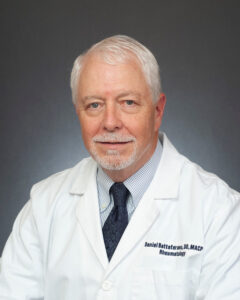The ACR recently created a new standing committee devoted to addressing long-term workforce solutions in rheumatology, the ACR Workforce Solutions Steering Committee. At its helm is Daniel F. Battafarano, DO, MACP, MACR.

Dr. Battafarano
Dr. Battafarano brings more than 35 years of leadership and experience in graduate medical education (GME) in rheumatology and internal medicine to the post. He holds multiple academic positions: adjoint professor of medicine at the University of Texas Health and University of the Incarnate Word College of Osteopathic Medicine, both in San Antonio, and professor of medicine at the Uniformed Services University of the Health Sciences, Bethesda, Md. For 15 years, he served as civilian chair and professor of medicine for the Rheumatology Service at Brooke Army Medical Center (BAMC), Fort Sam Houston, Texas. A room at BAMC—the Colonel Daniel F. Battafarano Education Conference Room—was dedicated to him in honor of his many contributions to medical education.
Here, Dr. Battafarano describes the goals of the ACR Workforce Solutions Steering Committee, his plans for the committee over the next few years and why he chose rheumatology as a specialty.
The Rheumatologist (TR): What does the Workforce Solutions Committee do?
Dr. Battafarano: The ACR Workforce Solutions Committee’s mission is to innovate and implement workforce solutions to train and sustain high-quality adult and pediatric rheumatology care in underserved communities, while partnering with local stakeholders. The committee includes a diverse group of multidisciplinary members.
The ACR Board of Directors approved the task force’s recommendations in October 2021 to pursue five primary interventions to address workforce shortages in the most underserved rheumatology regions of the U.S.: the Northwest, Southwest and south-central regions. These interventions include 1) promoting new fellowship programs and training primary care providers; 2) enhancing recruitment opportunities from medical students to practice options; 3) fostering patient-centered communities with regional stakeholders; 4) integrating virtual training programs to support multidisciplinary rheumatology teams; and 5) promoting training and research grants to financially support these underserved regions. More than 50 ACR/ARP volunteers plus a team of workforce consultants are leading and supporting these initiatives, and we are working collaboratively with other ACR committees to facilitate workforce solutions.
TR: What are your plans and goals for the committee over the next year or two?
Dr. Battafarano: The ACR and the Rheumatology Research Foundation are collaborating on financial strategies to support long-term workforce solutions and initiatives for rheumatology care. Many of these initiatives fall under the umbrella of the five primary interventions listed above. We recently held a call with GME leadership from 10 institutions with current resident programs in the Northwest, Southwest and south-central who have expressed interest in establishing or expanding rheumatology fellowships. The programs are at various decision-making points, and we anticipate working with them in the coming months to grow fellowships in these underserved areas.


